| Back Number | No.24 2005/09/14 | |||
| News | Closing Week: Toward the Finale of EXPO 2005 |  |
||
| Pavilions | Bangladesh
Pavilion (Global Common 1) Italy Pavilion (Global Common 3) Hellenic Pavilion (Global Common 3) Morocco Pavilion (Global Common 3) |
|||
| Column | The Emergency Medical System and Lost-child Framework Supporting EXPO 2005 | |||
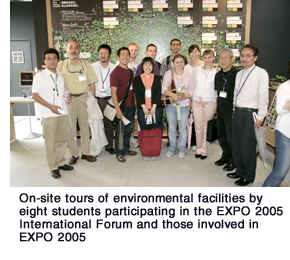 There are now less than two weeks left to EXPO 2005 Aichi, Japan, which opened on March 25 under the theme “Nature’s Wisdom.” Approximately 19 million people, far above the originally forecasted 15 million, have already visited the EXPO, and it is nearing its conclusion on a high note. The Japan Association for the 2005 World Exposition will be communicating the significance and results of EXPO 2005 by positioning the week up to the Closing Ceremony as Closing Week.
There are now less than two weeks left to EXPO 2005 Aichi, Japan, which opened on March 25 under the theme “Nature’s Wisdom.” Approximately 19 million people, far above the originally forecasted 15 million, have already visited the EXPO, and it is nearing its conclusion on a high note. The Japan Association for the 2005 World Exposition will be communicating the significance and results of EXPO 2005 by positioning the week up to the Closing Ceremony as Closing Week.To be held on Wednesday, September 21 at EXPO Dome is the EXPO 2005 Message Events’ EXPO 2005 International Forum. The Closing Forum of the EXPO 2005 International Forums hosted by the Japan Association for the 2005 World Exposition is the grand sum of the six symposiums which have so far been held. Centered around eight international students from countries of five continents - the United States, Australia, China, Mexico, Morocco, Russia and Switzerland - studying in Aichi Prefecture, the host of EXPO 2005, and a Japanese student who will be participating at the main venue, students from universities in Beijing, China; Amsterdam, the Netherlands; and Aichi Prefecture, Japan will be discussing through Internet hookups between EXPO Dome, Beijing and Amsterdam, the role and responsibilities of youths who will lead the next generation in relation to the form of sustainable society proposed by EXPO 2005. Furthermore, the EXPO 2005 International Workshop to be held that evening will be communicating the EXPO 2005 “Message to the Future” through musical performances. Scheduled for Thursday, September 22 is the 5th International Council Meeting. Seven council members, including Ole Philipson, President of the International Council of EXPO 2005, will be reviewing and assessing the fruits of EXPO 2005 and are scheduled to make proposals for the future. The results of and proposals by EXPO 2005 will be turned over to the 2010 Shanghai World Expo. This will be launched by the Aichi-Shanghai Joint Symposium to be held on Friday, September 23. After addresses by representatives from the Shanghai city government, the president of the International Exhibitions Bureau (Bureau International des Expositions: BIE), representatives from the Japanese government and others, active discussion is expected by leading Japanese and overseas researchers and corporate executives under the theme “World Expos Facing Sustainable Development.” YUMING Love the Earth Final will be held at EXPO Dome that same evening. Leading Japanese artist, singer/songwriter Yumi Matsutoya and artists from various countries in Asia will be performing songs written especially for this event and communicating, from Japan to Asia, the world and on to Shanghai, the “Love the Earth” message, in which people reconfirm their ties with nature and the Earth. |
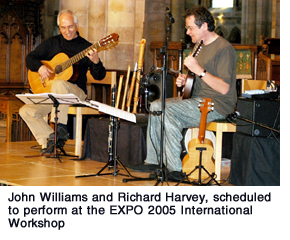 Saturday, September 24 is the BIE Special Day to be held at EXPO Dome. BIE will be wrapping up the National Days and Special Days held by the 120 official participant countries and international organizations, kicked off by the Ireland National Day on March 31. A performance of the Gundoku group recitation of “One Seed,” an epic poetic drama that has been held daily at Japan Pavilion Seto to rave reviews, will represent Japan. Elaborate performances from the cities of Zaragosa (Spain) and Shanghai (China), which will be hosting world expositions in 2008 and 2010, are also scheduled.
Saturday, September 24 is the BIE Special Day to be held at EXPO Dome. BIE will be wrapping up the National Days and Special Days held by the 120 official participant countries and international organizations, kicked off by the Ireland National Day on March 31. A performance of the Gundoku group recitation of “One Seed,” an epic poetic drama that has been held daily at Japan Pavilion Seto to rave reviews, will represent Japan. Elaborate performances from the cities of Zaragosa (Spain) and Shanghai (China), which will be hosting world expositions in 2008 and 2010, are also scheduled.The BIE Special Day Reception is scheduled that evening, and an award presentation ceremony for the recipient countries of the first and second Nature’s Wisdom Award, selected based on the evaluation of the pavilions of 120 countries and four international organizations exhibiting at EXPO 2005, is scheduled to be held. And finally, the Closing Ceremony of EXPO 2005 Aichi, Japan will be held on the afternoon of Sunday, September 25. EXPO 2005 will close at EXPO Dome, where the sounds of trumpets performed by robots resounded and more than 120 participating countries and international organizations gathered six months ago for the opening ceremony, shown around the world, to present a vision to be passed down to the next generation. |
![]()
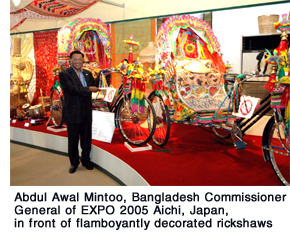 Bangladesh, a south Asian country facing the Bay of Bengal, is a nation of greenery surrounded by prairies that developed from fertile the deltas of the great Brahamapaputra, Meghna and Ganges rivers and their tributaries.
Bangladesh, a south Asian country facing the Bay of Bengal, is a nation of greenery surrounded by prairies that developed from fertile the deltas of the great Brahamapaputra, Meghna and Ganges rivers and their tributaries.Abdul Awal Mintoo, Bangladesh Commissioner General of EXPO 2005 Aichi, Japan said, “The Bangladesh Pavilion is focused on exhibits that are all related to nature, such as fabrics woven from natural materials including jute and silk, and rickshaws that are environmentally-friendly vehicles that create no pollution. They are things that the people of Bangladesh use on a daily basis. The life of the people of Bangladesh is always very closely related to nature.” One of the exhibits of the Bangladeshi Pavilion that is attracting much attention of visitors are the bicycle-powered rickshaw taxis, the name of which originated from the Japanese word “jinrikisha,” which literally means a carriage powered by man. There is a rickshaw displayed by the entrance of the pavilion as well as two more exhibited inside. The rickshaws of the Bangladesh Pavilion are hard to miss as they are flamboyantly decorated with plastic imitation flowers and colorfully painted panels. The rickshaws on display at EXPO 2005 were not especially lavishly decorated for the EXPO. They are just like those that can be found in major cities as well as the countryside of Bangladesh. Surprisingly enough, according to Abdul Awal Mintoo, there are said to be about two million such rickshaws serving as daily modes of transport in Dhaka alone to commute to work, school or to go shopping. The Bangladesh Pavilion provides an opportunity for visitors to experience an ecological lifestyle while also coming into contact with the country that continues to develop socially and economically. |
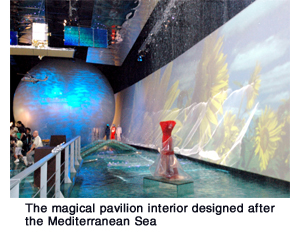 The Mediterranean, surrounded by Europe, Africa and the Middle East, has seen since the time before Christ, the rise and fall of many coastal countries battling to dominate this sea. Italy is located at the center of the Mediterranean Sea. EXPO 2005 Aichi, Japan's Italy Pavilion welcomes visitors with a water-filled magical space reminiscent of the Mediterranean Sea.
The Mediterranean, surrounded by Europe, Africa and the Middle East, has seen since the time before Christ, the rise and fall of many coastal countries battling to dominate this sea. Italy is located at the center of the Mediterranean Sea. EXPO 2005 Aichi, Japan's Italy Pavilion welcomes visitors with a water-filled magical space reminiscent of the Mediterranean Sea.At the zone imaging the Mediterranean Sea, objects such as a scale model of a glass bridge that is hoped to replace a wooden bridge in front of the Venetian Arsenal in the future are on display. A showcase on the wall introduces products and projects representative of the Italian industrial world, such as a robotic arm equipped with a touch sensor being jointly researched by Sant’Anna School of Advanced Studies in Pisa and Japan’s Waseda University, and the parts of world-famous cars, such as those made by Ferrari. Consideration for the environment has, of course, been made at the pavilion, including the use of recycled flooring material mixed with waste glass mirrors. Awaiting visitors in a nine-meter-diameter room ahead is “The Dancing Satyr.” This bronze statute, which captures the leap of a satyr - an attendant of Bacchus - dancing limberly filled with drink, was made more roughly 2,400 years ago in Greece. It was caught in a fishing net off the coast of Sicily and raised from the ocean floor in 1998. This is the first time that this miraculously discovered statue has been taken out of Italy. It is said that it is highly likely that this will be the first and last time that The Dancing Satyr will be seen outside of Italy, so it is a definite must-see. The Italy Pavilion, the theme of which is “The Art of Living,” is one in which visitors will be able to feel the artistic quality of the nation that stands out prominently in areas such as fashion and industrial design, as well as the spiritually affluent lifestyle of the people and the eternal history that nurtured them. |
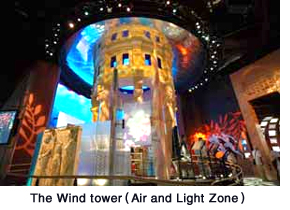 The Hellenic Pavilion is focused around four zones that express the elements of nature: earth, wind, water and fire. It uses exquisite colors and artistic lighting effects as well as décor and sculptures reminiscent of ancient Greece to create a mystical and beautiful space.
The Hellenic Pavilion is focused around four zones that express the elements of nature: earth, wind, water and fire. It uses exquisite colors and artistic lighting effects as well as décor and sculptures reminiscent of ancient Greece to create a mystical and beautiful space.Rising high at the center of the pavilion in the Air and Light Zone is the Wind tower, designed after a temple of the second century B.C. where people offered their prayers to the gods of the winds. Stepping inside the tower, visitors will see at their feet, a map depicting a bright blue Aegean Sea and the land of Greece. And, when they look around them at the eight pillars of the tower, they will meet Zephyrus, the god of the west wind, and other Greek gods of the four directions of the winds. This tower represents the Greek respect of nature, and the spirit of the Greek people who continue to live in harmony with nature. In other words, it represents the pavilion’s theme of Nature - Measure - Humans. The Water Zone is an expression of Greece’s abundant blessings of water in a country where people have lived together with the sea. The Earth Zone introduces flora and fauna nurtured by the country’s diverse landscape and four seasons, from the Aegean Sea that glitters in the sun to white snow-covered mountains. And, the Zone of Fire allows visitors a glimpse into the high artistic quality and spirituality of Greece through an ancient amphitheater and choreographic performances projected therein. After these four zones is the Interactive Zone where visitors can access information using touch-panel screens. It includes descriptions of Greece’s current efforts towards the development of renewable energy, such as wind and solar power. The Hellenic Pavilion that disseminates the wisdom of humankind, which has lived in harmony with nature since ancient times, to the world, received the Bronze Prize in EXPO 2005 Aichi, Japan’s Nature’s Wisdom Award. |
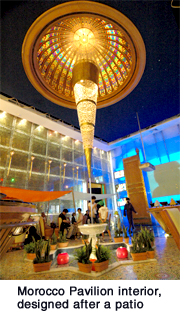 The exterior of the Morocco Pavilion, with the bright green of date palms protruding from its outer walls of burnt sienna, is quite eye catching. This unique exterior is a recreation of the scenery of the Kasbah Street or Route, which leads from the desert to the oasis and are studded with ancient citadel made of red soil.
The exterior of the Morocco Pavilion, with the bright green of date palms protruding from its outer walls of burnt sienna, is quite eye catching. This unique exterior is a recreation of the scenery of the Kasbah Street or Route, which leads from the desert to the oasis and are studded with ancient citadel made of red soil.When visitors step into the pavilion interior through a somewhat narrow entrance, they will find, opening up before their eyes, a space designed after a Moroccan patio. Patios are a place of relaxation in Moroccan traditional homes. One can sense that it was designed as a place that visitors to the pavilion can enjoy in comfort to their heart’s content. The pride of the Morocco Pavilion, which embodies the theme “Art of Living,” is the magnificent and gorgeous interior where no pain has been spared in the making. For example, the exquisite brass engravings (1 meter square) of geometric patterns that decorate the wall are elaborate items that each took experienced craftsmen a full month to complete. Each brass engraving is covered by glass on both sides, and 312 of them are connected together. The Zellige, the mosaic tiles, that add color to the floor, the conical fountain at the center of the pavilion that expresses water as the blessing from the heavens, and the dome-shaped stained glass at the top of the fountain were all expressly made for EXPO 2005 Aichi, Japan. Other features of the pavilion include the Souk (Arabian word for market) Corner, where visitors can bargain with shop attendants, just as if they were in Morocco, to purchase ethnic costumes, handicrafts and other items. It should be enjoyable to negotiate for the right price that is to everyone's satisfaction. Visitors can also sit at the café in the pavilion and take pleasure in the gorgeous surroundings around them while enjoying a cup of Moroccan coffee or mint tea. Incidentally, this conspicuously beautiful Morocco Pavilion received the Silver Prize in EXPO 2005’s Nature’s Wisdom Award. |
![]()
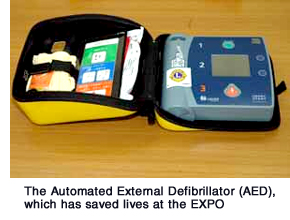 On June 1 this year, a 42 year-old man visiting the EXPO 2005 Aichi, Japan venue suddenly collapsed and went into cardio-respiratory arrest. Four medical students who happened to be there used an automated external defibrillator (AED) installed at the venue to resuscitate the man and looked after him until a doctor and paramedics arrived. Although hospitalized for about two months, the man recovered without any after effect. While it is said that the chance of survival for a person is normally 50% after three minutes have passed after going into cardio-respiratory arrest, the emergency medical system at EXPO 2005 and the swift response of visitors saved a person’s life.
On June 1 this year, a 42 year-old man visiting the EXPO 2005 Aichi, Japan venue suddenly collapsed and went into cardio-respiratory arrest. Four medical students who happened to be there used an automated external defibrillator (AED) installed at the venue to resuscitate the man and looked after him until a doctor and paramedics arrived. Although hospitalized for about two months, the man recovered without any after effect. While it is said that the chance of survival for a person is normally 50% after three minutes have passed after going into cardio-respiratory arrest, the emergency medical system at EXPO 2005 and the swift response of visitors saved a person’s life.There are three clinics and five first aid stations at the EXPO 2005 venue that constantly provide first aid to EXPO visitors, but a feature of its medical services is that emphasis has been placed on emergency response. The installation of AEDs, which arrest fibrillation of the heart muscle at times of emergency by providing strong electric shocks, is one such example. While AEDs are installed at various dispersed locations at airports abroad, they are not yet widespread in Japan. However, in the understanding that they are indispensable for an emergency medical system, 100 of them were installed at EXPO 2005, with one unit installed every 60 to 70 meters in major areas where many people gather. The roughly 5,000 EXPO staff members at the venue who have undergone first aid training know how to use the AED. What is most reassuring is that each staff member is familiar with the EXPO’s emergency medical response system. Three lives have already been saved by use of the AED and all have achieved a safe return to society. |
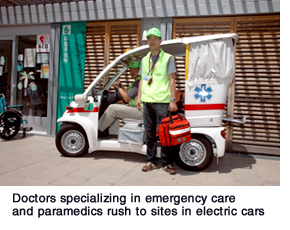 Upon receiving word that there is a person in critical condition who does not move or respond to verbal stimuli, staff members notify command headquarters by radio or telephone. At the same time, staff members conduct basic life support measures such as cardiac massage. The command headquarters sends a doctor specializing in emergency care and paramedics to the site in electric cars, while at the same time, a call for an ambulance to transport the patient to medical facilities outside of the venue is made.
Upon receiving word that there is a person in critical condition who does not move or respond to verbal stimuli, staff members notify command headquarters by radio or telephone. At the same time, staff members conduct basic life support measures such as cardiac massage. The command headquarters sends a doctor specializing in emergency care and paramedics to the site in electric cars, while at the same time, a call for an ambulance to transport the patient to medical facilities outside of the venue is made.Staff members who receive word of patients in moderate to light condition notify the nearest clinic or first aid station in the venue. Resident doctors, nurses or others go to pick the patient up in electric cars or customized wheelchairs, according to the situation. |
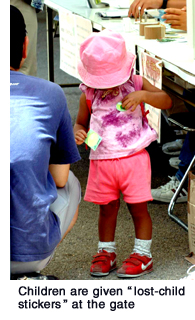 Emergencies at the EXPO do not consist just of illnesses or injuries. There are many cases in which children, the elderly of those with handicaps get separated from their families, etc. There is also concern of the occurrence of incidents such as kidnapping. However, most cases of children or persons getting lost are resolved within about 10 minutes at the EXPO venue. This is because the “lost-child sticker” and the “lost-child search system” have been displaying their strength.
Emergencies at the EXPO do not consist just of illnesses or injuries. There are many cases in which children, the elderly of those with handicaps get separated from their families, etc. There is also concern of the occurrence of incidents such as kidnapping. However, most cases of children or persons getting lost are resolved within about 10 minutes at the EXPO venue. This is because the “lost-child sticker” and the “lost-child search system” have been displaying their strength.When parents with children between the ages of about two and seven go through the entrance gate, volunteers and staff members hand them with a lost-child sticker. These stickers are also available at the baby carriage counter. If desired, they are also provided to the elderly and the disabled. These 4.5cm-diameter round stickers, which are used by removing them from their mounts, are placed on the clothing of children. The mount that the parents keep and the stickers have the same number printed on them and are used when cross-checking the identity of a lost child. Although voluntary from the perspective of protecting personal information, there is space on the stickers to write the parents’ mobile phone number. Staff members who find a lost child first call the mobile phone number written on the sticker. When there is no such number written on the sticker, they search the perimeters. If they still cannot reunite the child with their parents after about ten minutes, the staff member who found the lost child or has been contacted by a parent sends necessary information, such as the number on the lost-child sticker, name and description of the child’s clothing, to the Lost Child Center from the closest security box or information center, which is then input on the intranet. This information can be searched at the personal computers at the service facilities of the EXPO, such as the Lost Child Center and security boxes, as well as the PDAs (Personal Digital Assistant) held by the multi-staff who make a tour of the venue. Each can search such information via the intranet. Intranet searches and response is also available outside the venue at adjacent terminals, the Park & Ride and Linimo nodule stations. Although the number written on the stickers is the most decisive means for reuniting lost children with parents, even just information such as a description of the clothing worn by the child is usually sufficient for finding them. With less than two weeks left to EXPO 2005 Aichi, Japan, the ardent prayer-like wishes of the staff members to prevent the loss of any life or the occurrence of any tragic incidents continues to support the systems every day. |
| EXPO 2005 AICHI, JAPAN Newsletter | |
| To read past issues:Back Number | |
| Editor/Publisher: Japan Association for
the 2005 World Exposition Head Office: 1533-1 Ibaragabasama, Nagakute-cho Aichi 480-1101 Japan Nagoya Office: Nagoya Daiya II Bldg 4F, 3-15-1 Meieki Nakamura-ku, Nagoya, Aichi 450-0002 Japan Tokyo Office: Iino Bldg 8F, 2-1-1 Uchisaiwai-cho Chiyoda-ku, Tokyo 100-0011 Japan |
 |
© Japan Association for the 2005 World Exposition
